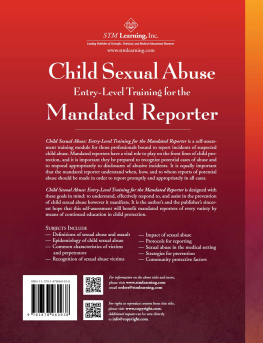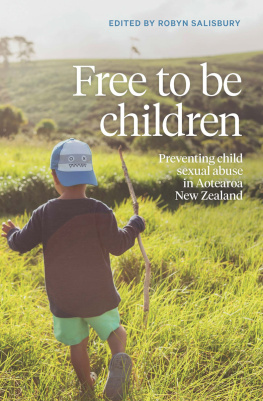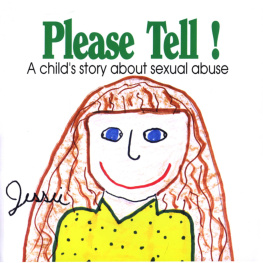Contents
Pagebreaks of the print version


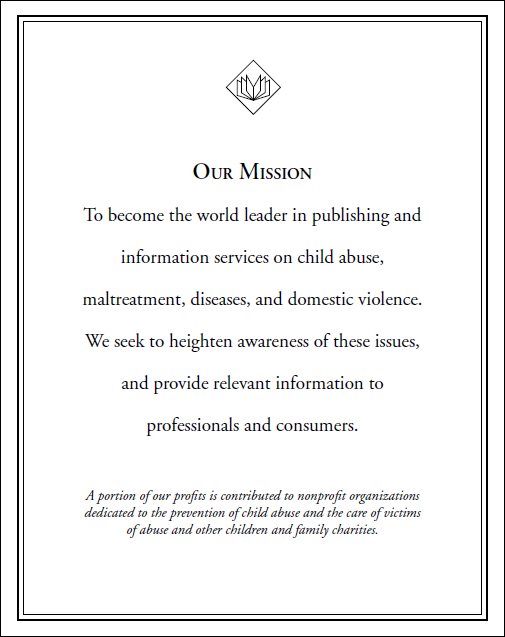
If you are an employee of an organization that offers an Employee Assistance Program, take advantage of it. If you need referral assistance to find local resources, you can call national organizations such as The Childhelp National Child Abuse Hotline: 1-800-4-A-CHILD (1-800-422-4453). If you or someone else is in immediate danger, call your local emergency number or 911.

Adrienne D. Atzemis, MD
Assistant Professor, Pediatrics
Section of Child Abuse Pediatrics
Program Director, Child Abuse Pediatrics Fellowship
Washington University School of Medicine
Saint Louis, MO
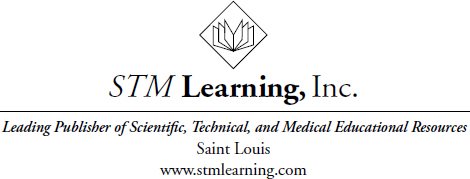
Publishers: Glenn E. Whaley and Marianne V. Whaley
Graphic Design Director: Glenn E. Whaley
Managing Editor: Paul K. Goode, III
Book Design/Page Layout: Jennifer M. Jones and GW Graphics
Print/Production Coordinator: Jennifer M. Jones and GW Graphics
Cover Design: Jennifer M. Jones and GW Graphics
Color Prepress Specialist: Kevin Tucker
Acquisitions Editor: Glenn E. Whaley
Copy Editor: Lindsay Westbrook
Proofreader: Paul K. Goode, III
Copyright 2015 STM Learning, Inc.
All rights reserved. No Part of this publication may be reproduced, stored in a retrieval system, or transmitted in any form or by any means, electronic, mechanical, photocopying, recording, or otherwise, without prior written permission from the publisher.
Printed in the United States
Publisher:
STM Learning, Inc.
55 Westport Plaza, Suite 455, Saint Louis, Missouri, 63146-3128 USA
Phone: (314)434-2424 Fax: (314)434-2425
http://www.stmlearning.com
Library of Congress Cataloging-in-Publication Data
Atzemis, Adrienne D., 1974- , author.
Child sexual abuse entry-level training for the mandated reporter/ Adrienne D. Atzemis.
p. ; cm.
Includes bibliographical references.
ISBN 978-1-878060-93-8 -- ISBN 1-878060-93-7
I. Title.
[DNLM: 1. Child Abuse, Sexual--United States--Examination Questions. 2. Child Abuse, Sexual--United States--Programmed Instruction. 3. Mandatory Reporting--United States--Examination Questions. 4. Mandatory Reporting--United States--Programmed Instruction. WA 18.2]
RJ507.S49
616.858360076--dc23
2014050072
FOREWORD
Whether you are a mandated reporter of child sexual abuse or a concerned citizen who values children and families in our society, this easily read, concise, and well-written manual is for you. This nicely organized little text will be valuable to those whose professional work or employment places them in contact with children and teens or their families. It will also be useful for training employees in multiple settings where children are encountered.
Programs in social work, forensics, mental health, criminal justice, education, child advocacy, daycares, general hospital staff, etc, will find this compact manual ideal for courses on child abuse. Undergraduate professors and high school teachers will benefit from the knowledge this manual imparts for teaching classes on human behavior/development, social responsibility, etc.
The manual is divided into 3 chapters. Each begins with a set of clear objectives. A lesson outline follows. Within the outlines are learning activities which direct the reader to become actively engaged in enhancing his/her knowledge (eg, by performing an online search). The reader is then asked to answer questions to solidify the newly mastered material. The outlines also are embedded with questions, many of which the reader might be formulating about the time the question appears. Tables and Web sites for additional references add to readability and efficiency of this gem. The manual concludes with a set of questions for review and/or class discussion or evaluation, followed by excellent references.
In , the reader will be introduced to the definition and epidemiology of sexual abuse, its victims, and its perpetrators. Signs that might suggest a child has been/is being abused are listed and the process of disclosure is discussed. Why children often delay telling about their abuse is explained, as well as the possible effects of sexual abuse.
, Responding to Child Sexual Abuse, differentiates the mandated reporter from a permissive reporter, addressing concerns about making false reports and penalties for failing to report. Perhaps most of interest, Dr. Atzemis makes suggestions for how to act and what to say when a child discloses abuse. She then explains the investigative process, describing a multidisciplinary team and the use of child advocacy centers (CACs). As a child abuse pediatrician, Dr. Atzemis is particularly adept at discussing the importance of offering a medical examination for every child who may have been sexually abused. Why most children who have been sexually abused have normal examinations is also elucidated, correcting the myth that a health care provider can readily prove whether a child has been sexually abused.
Although brief, the third chapter on Prevention of Child Sexual Abuse is terribly important. It challenges all of us to make our own commitment to prevention efforts. In the past most efforts for prevention were directed only at children and teens, but parents, communities, organizations, and government agencies, as well as potential abusers, must be enlisted in this fight. Families and caretakers must be strengthened to protect our children.
Dr. Atzemis will have convinced us that child sexual abuse is a complex problem and the prevention of child sexual abuse is equally complex.
Linda J. Shaw, MD, MSSW
Adjunct Associate Professor
Division of Child Protection
Department of Pediatrics
Saint Louis University School of Medicine
Saint Louis, MO
PREFACE
Acts of sexual abuse can be committed against children in every social stratum, against boys as well as girls, and against children of all ethnicities. No particular group is entirely safe from harm at the hands of sexually abusive adults, adolescents, or peers who may be, and frequently are, family members, trusted friends, or authority figures charged with their care. In the interest of child welfare and the greater public good, it behooves those who will, in the course of their professional responsibilities, care for, or otherwise come into contact with children, to understand the nature of sexual abuse and to recognize its telltale signs in order to identify and report suspected abusive incidents and to ensure the safety of abused children.
Child Sexual Abuse: Entry-Level Training for the Mandated Reporter is a self-assessment training module for those professionals bound to report incidents of suspected child abuse. Mandated reporters have a vital role to play on the front lines of child protection, and it is important they be prepared to recognize potential cases of abuse and to respond appropriately to disclosures of abusive incidents. It is equally important that the mandated reporter understand when, how, and to whom reports of potential abuse should be made, in order to report promptly and appropriately in all cases.

